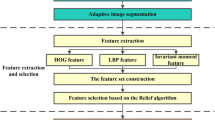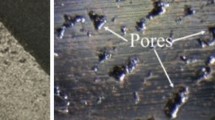Abstract
Abrasive protrusion height (APH) is the core parameter of abrasive tools, and it is also a principal parameter for modeling and simulation of the surface topography of abrasive tools. Because of the difficulty in obtaining the 3D feature information of abrasives and the limited measured data; this study proposes an APH model based on the spatial projection relationship. Combined with the gradient boosting decision tree (GBDT) intelligent algorithm, the APH characteristics of the abrasive tool are quickly generated by the data-fusion learning model. Through the corresponding experiments, we acquired the 2D image of the abrasive tool and extracted the area information of the abrasive projection area. The result shows that the fitting degree R2 of the algorithm model reaches 0.911. Comparing the APH generated based on the algorithm model with the actual one, the average accuracy is about 94.69% and the mean absolute error of generated protrusion height MAE is 5.31 μm, which validates the proposed model. The results of this study demonstrate that the data-driven approach can effectively establish the generation model of the protrusion height of abrasive grains, which not only enable the measurement of the protrusion height of abrasive but also provide a reference for accurate modeling of abrasive tools.














Similar content being viewed by others
Data availability
The datasets used or analyzed during the current study are available from the corresponding author on reasonable request.
References
Deja M, Zieliński D (2020) Wear of electroplated diamond tools in lap-grinding of Al2O3 ceramic materials. Wear 460–461:203461
Chen J, Sun T, Su J, Li J, Zhou P, Peng Y, Zhu Y (2020) A novel agglomerated diamond abrasive with excellent micro-cutting and self-sharpening capabilities in fixed abrasive lapping processes. Wear 203531:464–465
Chen S, Cheung CF, Zhang F, Zhao C (2018) Three-dimensional modelling and simulation of vibration marks on surface generation in ultra-precision grinding. Precis Eng 53:221–235
Liu W, Deng Z, Shang Y, Wan L (2019) Parametric evaluation and three-dimensional modelling for surface topography of grinding wheel. Int J Mech Sci 155:334–342
Zhang Y, Fang C, Huang G, Xu X (2018) Modeling and simulation of the distribution of undeformed chip thicknesses in surface grinding. Int J Mach Tools Manuf 127:14–27
Tamaki J, Kitagawa T (1995) Evaluation of surface topography of metal-bonded diamond wheel utilizing three-dimensional profilometry. Int J Mach Tools Manuf 35(10):1339–1351
Yan L, Rong YM, Jiang F, Zhou ZX (2011) Three-dimension surface characterization of grinding wheel using white light interferometer. Int J Adv Manuf Technol 55:133–141
Hou ZB, Komanduri R (2003) On the mechanics of the grinding process – part I. Stochastic nature of the grinding process. Int J Mach Tools Manuf 43:1579–1593
Chen H, Zhao J, Wang Z, Dong J, Yu T (2021) Modeling virtual abrasive grain based on random ellipsoid tangent plane. Int J Adv Manuf Technol 113:2049–2064
Malkin S (1989) Grinding technology: theory and applications of machining with abrasives. Ellis Horwood, New York
Aurich JC, Kirsch B (2012) Kinematic simulation of high-performance grinding of analysis of chip parameters of single grains. CIRP J Manuf Sci Technol 5:164–174
Ding W, Dai C, Yu T, Xu J, Fu Y (2017) Grinding performance of textured monolayer CBN wheels: undeformed chip thickness nonuniformity modeling and ground surface topography prediction. Int J Mach Tools Manuf 122:66–80
Yoshikawa H, Sata T (1968) Simulated grinding process by Monte Carlo method. CIRP Ann Manuf Technol 16:297–302
Huang S, Duan N, Chen X, Yu Y, Xu X (2013) Image mosaic coupled detection of grinding wheel topographies. Int J Abras Technol 6:147–157
Cui C, Xu X, Huang H, Hu J, Ye R, Zhou L, Huang C (2013) Extraction of the grains topography from grinding wheels. Measurement 46:484–490
Lin Y, Fang C (2018) Study on the segmentation of abrasive grains in diamond tools. Int J Abras Technol 8:203–217
Lin Y, Wu L (2019) Improved abrasive image segmentation method based on bit-plane and morphological reconstruction. Multimedia Tools Appl 78:29197–29210
Yu H, Lu Y, Wang J (2016) Study on wear of the grinding wheel with an abrasive phyllotactic pattern. Wear 358–359:89–96
Zhang Y, Xu X (2021) Predicting the material removal rate during electrical discharge diamond grinding using the Gaussian process regression: a comparison with the artificial neural network and response surface methodology. Int J Adv Manuf Technol 113:1527–1533
Sizemore N, Nogueira M, Greis N, Davies M (2020) Application of machine learning to the prediction of surface roughness in diamond machining. Procedia Manuf 48:1029–1040
Xie W, Wang J, Xing C, Guo S, Guo M, Zhu L (2020) Extreme learning machine soft-sensor model with different activation functions on grinding process optimized by improved black hole algorithm. IEEE Access, 825084–25110.
Zhang B, Katinas C, Shin YC (2020) Robust wheel wear monitoring system for cylindrical traverse grinding. IEEE/ASME Trans Mechatron 25:2220–2229
Funding
This work was financially supported by the National Natural Science Foundation of China (No.52275426, No.51675193).
Author information
Authors and Affiliations
Contributions
All the authors have been involved equally in the realized work.
Corresponding author
Ethics declarations
Ethics approval
All data in this paper comes from machining grinding experiments and does not involve ethical issues.
Consent to participate
The authors declare that they consent to participate in this paper.
Consent for publication
The authors declare that they consent to publish this paper.
Conflict of interest
The authors declare no competing interests.
Additional information
Publisher's note
Springer Nature remains neutral with regard to jurisdictional claims in published maps and institutional affiliations.
Rights and permissions
Springer Nature or its licensor (e.g. a society or other partner) holds exclusive rights to this article under a publishing agreement with the author(s) or other rightsholder(s); author self-archiving of the accepted manuscript version of this article is solely governed by the terms of such publishing agreement and applicable law.
About this article
Cite this article
Li, H., Fang, C. Study on generation of abrasive protrusion height based on projection information–driven intelligent algorithm. Int J Adv Manuf Technol 123, 4309–4320 (2022). https://doi.org/10.1007/s00170-022-10474-y
Received:
Accepted:
Published:
Issue Date:
DOI: https://doi.org/10.1007/s00170-022-10474-y




